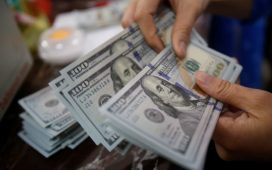
Investing.com – The U.S. dollar drifted marginally lower Friday, with activity muted ahead of the widely-watched monthly U.S. jobs report, and the Japanese yen set for its next week in more than a year.
At 04:25 ET (08:25 GMT), the Dollar Index, which tracks the greenback against a basket of six other currencies, traded 0.1% lower to 105.110, on course for its worst week in almost two months.
Dollar on back foot ahead of payrolls
has been on the back foot for most of this week, after Fed Chair largely ruled out rate hikes, signalling that the U.S. central bank was still leaning towards eventual rate cuts, even if they may take longer to come than initially expected.
“The post-FOMC bias has been markedly bearish on the dollar, and despite the U.S. payrolls risk event today, markets have continued to squeeze USD long positioning yesterday and overnight,” said analysts at ING, in a note.
Attention now turns to the closely-watched U.S. monthly employment report.
likely increased by 238,000 jobs last month after rising 303,000 in March, while the is seen holding below 4% for the 27th straight month.
Powell made it clear the importance of the upcoming economic data as far as policy decisions are concerned, after the U.S. central bank held interest rates unchanged on Wednesday.
Financial markets continue to expect the central bank to start its easing cycle in September, but strong numbers could see this window start to close.
remove ads
.
“All in all, our 210k call for payrolls means we do not expect today’s data to dent the bearish dollar momentum as markets may fully price in a cut in September and keep short-term USD rates capped,” ING added.
Eurozone manufacturing still weak
In Europe, traded 0.2% higher to 1.0743, helped by the recent dollar weakness.
However, the recent economic news out of the eurozone has hardly been helpful, with falling 0.3% on the month in March, according to data released earlier Friday.
The eurozone’s manufacturing sector remained in contraction territory in April, according to the final release on Thursday, while the VDMA association reported that German manufacturers deepened a decline in their order books in March.
The has signalled a rate cut in June, but there remains a great deal of uncertainty over what happens with monetary policy after this.
traded 0.2% higher to 1.2555, following the release of the number.
This showed an increase to 55.9 in April, from 53.1 the prior month, suggesting that the U.K.’s dominant services industry remains in a healthy state, potentially offering the Bank of England room to delay interest rate cuts.
Yen on course for hefty weekly gain
In Asia, fell 0.2% to 153.26, with the pair on course to report a weekly loss of well over 3%, its largest since December 2022.
Japanese authorities have been linked with intervention to support its currency this week to the tune of some 9.16 trillion yen ($59.8 billion), as suggested by data from the Bank of Japan.
remove ads
.
These forays into the currency market have tended to occur during periods of thin liquidity, with the country out for a holiday on Monday while the second attempt happened late on Wednesday after Wall Street had closed.
“The second round of JPY intervention in one week, deployed after a less hawkish than expected FOMC on Wednesday, has sent markets the message that the Ministry of Finance is less tolerant of a post-intervention depreciation of the yen this time,” ING said.
Broader Asian currencies rose slightly, capitalizing on an overnight drop in the dollar.
pair rose 0.3% to 0.6579, as markets positioned for potentially hawkish signals from the next week. Hotter-than-expected Australian inflation readings saw markets largely price out expectations of any rate cuts by the RBA in 2024, offering the Aussie some strength.











